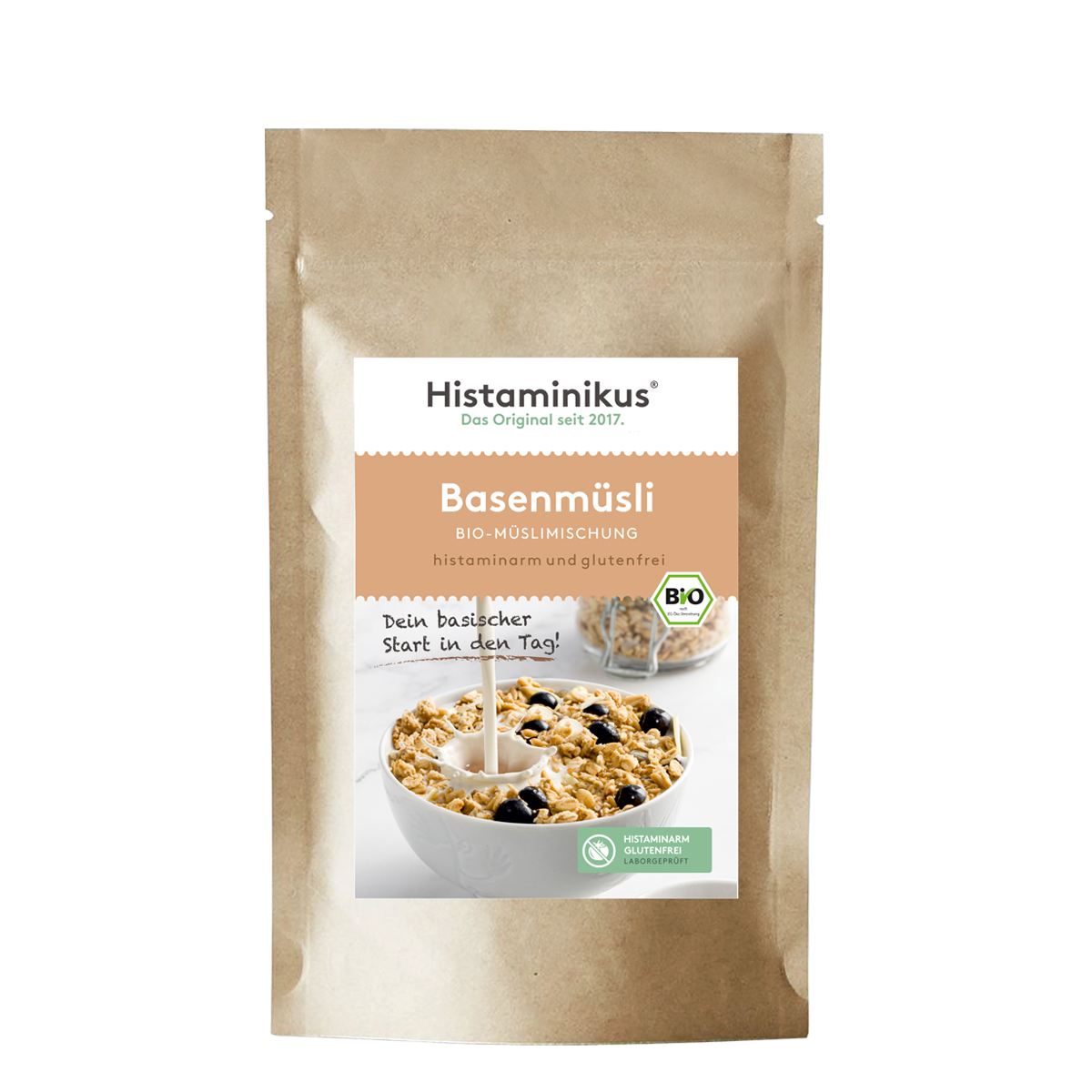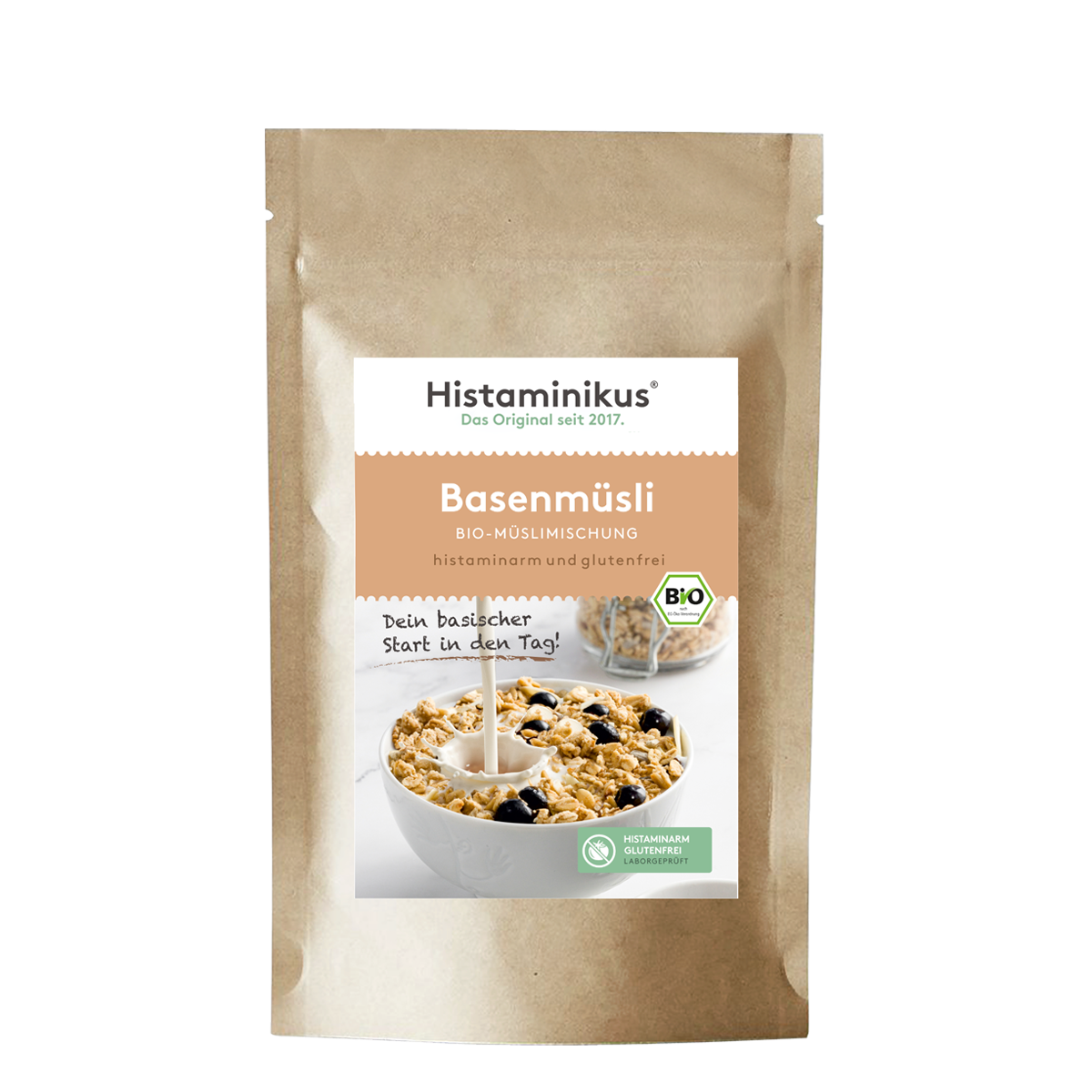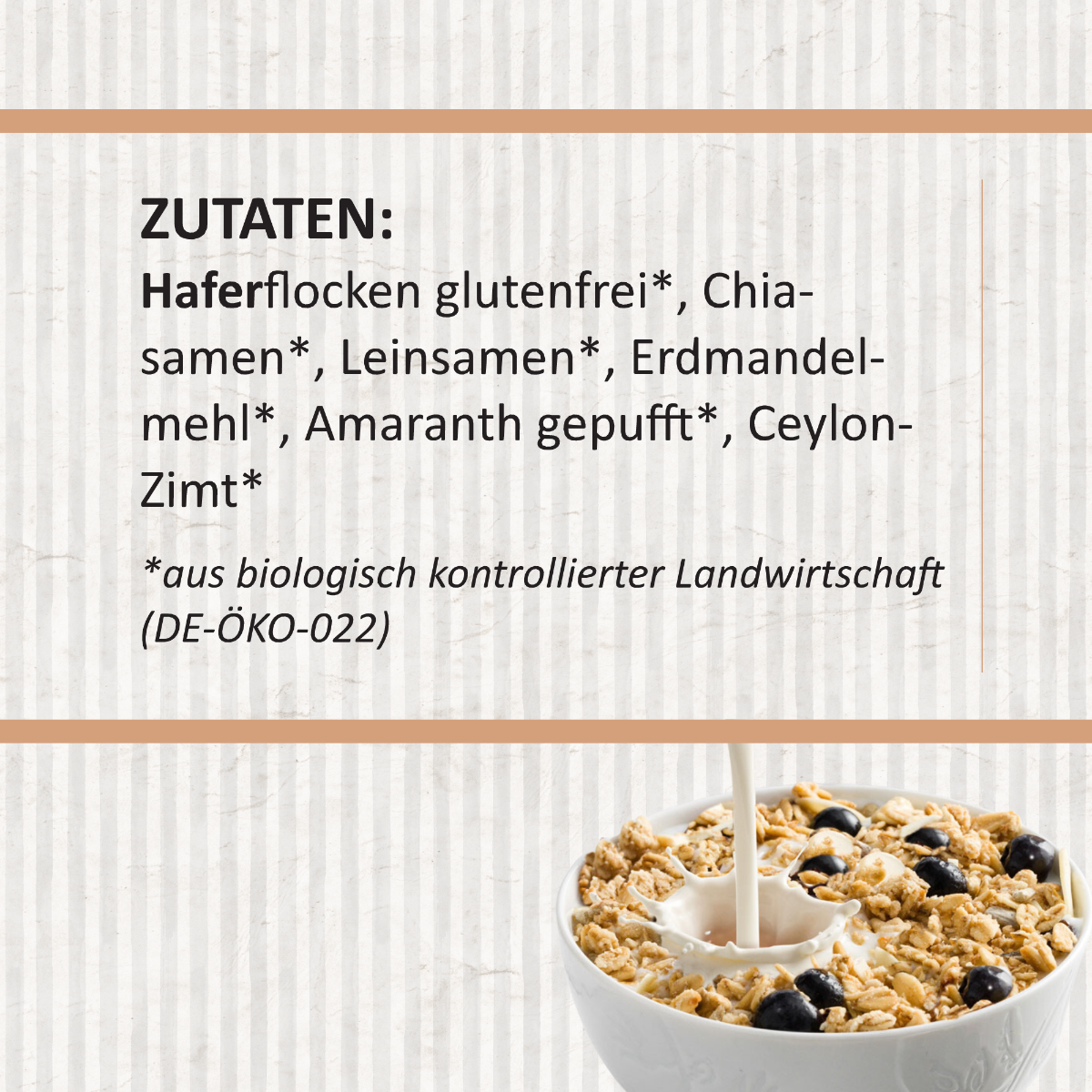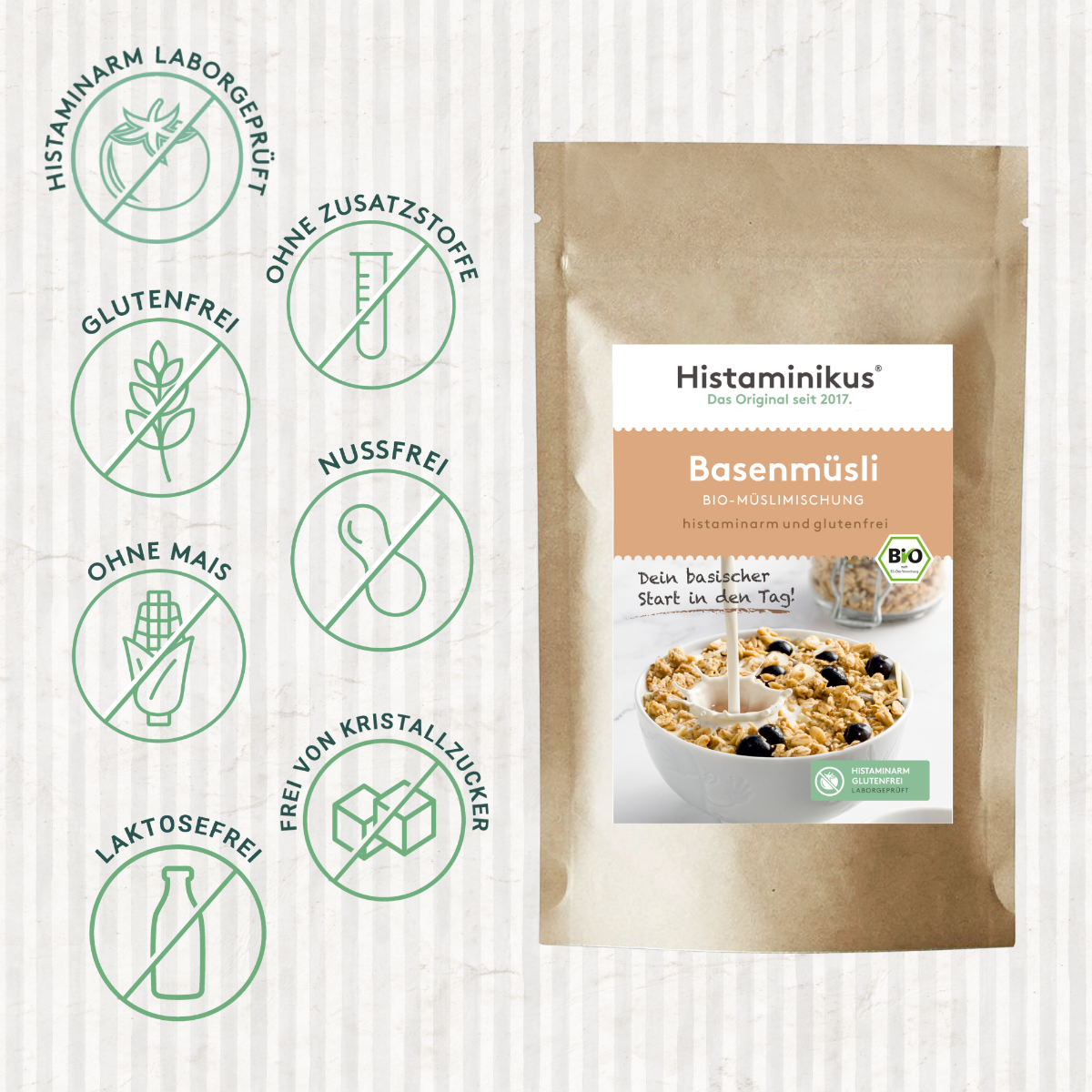
Diabetes and histamine
The common disease diabetes mellitus, often simply as "Diabetes“Described, is a collective term for different metabolic disorders. That Main characteristic There is a permanently increased blood sugar levels (= Hyperglycaemia). But did you know that this disease also has one Connection to histamine could give?
What is diabetes mellitus?
As already mentioned, the "diabetes" is a collective term for various metabolic disorders that are associated with a permanently increased blood sugar level. But not only the carbohydrate metabolism is affected- the fat and protein metabolism often gets out of balance. The hormone insulin is significantly involved in the processes. It regulates the metabolism of carbohydrates, fats and proteins and is produced by the beta cells of the pancreas. In the case of diabetes, insulin release can be disturbed or an absolute insulin deficiency occurs. In addition, important organs such as the brain, the liver, the muscles and adipose tissue no longer react correctly to insulin. This insulin resistance can occur in different forms and also contributes to the development of diabetes. In diabetes, a distinction is made between 2 different types:
🔹Type 1 diabetes
Type 1 diabetes is an autoimmune disease in which your own immune system attacks and destroys the insulin-producing cells in the pancreas. As a result, the body can no longer produce insulin. Without insulin, the sugar (glucose) contained in the food does not get properly into the body cells and cannot be used there as an energy source. That is why people with type 1 diabetes have to inject insulin their lives-several times a day and in individually adapted doses to keep the blood sugar level as stable as possible. This allows long -term damage to nerves and blood vessels to be prevented or at least delayed. Type 1 diabetes occurs primarily in children, adolescents and young adults and affects about 0.3 to 0.4 % of the population.
Possible symptoms:
• fatigue/fatigue
• weakness
• Hunger or loss of appetite
• Sudden weight loss
• Poor wounds
• strong thirst
• increased urination
• Susceptibility to infection
• blurred view
🔹Type 2 diabetes
Type 2 diabetes is particularly widespread-more than 90 % of all affected people suffer, which is why it is often referred to as "wealth disease". This affects adults from the age of 40, although many people know nothing about their illness for a long time. According to estimates, around 7.2 % of the population in 2012 had diagnosed diabetes, an additional 2.1 % were ill. According to the current data from the Robert Koch Institute, at least every fifth adult in Germany shows striking blood sugar levels. The dangerous thing about type 2 diabetes: it develops slowly and often remains unnoticed for years. In the beginning there are hardly any complaints, but the body remembers every sugar - a so -called "sugar -reason". Only after years do the consequences, such as nerve damage or circulatory disorders, especially on feet and lower legs are shown. One of the dreaded late consequences is the "diabetic foot syndrome" with poorly healing wounds, which in the worst case no longer heal. Developing type 2 diabetes, especially in people with high risk, should be screening on diabetes every 2 years as part of the check-up 35.
A hereditary disposition can play a role in the formation, but it alone does not necessarily lead to diabetes. The lifestyle is particularly crucial: excessive food in combination with too little movement promotes insulin resistance - i.e. a declining sensitivity of the body cells for insulin. A measure of insulin resistance is the so-called Homa index, which is calculated from the sober values of insulin and glucose. Ideally, this value should be below 2.5-it is often significantly higher for type 2 diabetics, usually over 5.0. If you often consume heavily processed carbohydrates (such as white bread, sweets or soft drinks), keep your pancreas out of trot. This can lead to the long term that the body no longer processes the sugar efficiently. People with insulin resistance often have a high insulin level in the blood, but the cells no longer really absorb the sugar.
A permanently increased insulin level has far -reaching consequences - the body stores more fat, especially in the abdomen and in the organs, which increases the risk of overweight and fatty liver. In addition, deposits can be formed in the blood vessels that significantly increase the risk of cardiovascular diseases. The lack of movement also tightens the problem because muscles usually use a large part of the blood sugar as an energy source. Those who move little gives the body to break down excess sugar - insulin resistance then progresses particularly quickly. In the worst case, the pancreas can no longer produce enough insulin and gives up completely. Then insulin must be supplied from the outside.
Symptoms are often much unspecific or less pronounced in people with type 2 diabetes than in people with type 1 diabetes. Nevertheless, there are overlaps.
Possible symptoms:
• Thirst
• frequent urination
• urinary tract infections
• Growth disorder, bedwetting, weight loss (in children)
• fatigue, weakness, dizziness
• Severage deterioration, changing prescription
• Dry skin, itching
• alternating loss of appetite and hunger attacks
• Potency disorders/Libidoverlust
• psychological changes such as aggressive behavior
• Muscle cramps
• Nerve diseases
• Poor wounds, especially on the feet
• nausea, abdominal pain
Diagnosis in type 2 diabetes
The blood sugar is first measured at the doctor, with a distinction between sober and occasional blood sugar. A normal sober blood sugar is a maximum of 100 milligrams per deciliter. Values up to 125 milligrams per deciliter can indicate prediabetes, while even higher values suggest suspected diabetes mellitus. In addition, a glucose tolerance test is often done and the so-called long-term blood sugar is determined. The glyco hemoglobin, ie the "intumed" blood pigment, provides information about the average blood sugar concentration of the last eight to twelve weeks. If diabetes is diagnosed, further examinations follow in order to identify possible complications at an early stage. This includes control of the eye background, blood pressure measurements and tests of nerve function, feet and kidney and blood lipid levels. A urine examination is also part of it.
Share information about your brand with your Customers. Describe A Product, Make Announcements, Or Welcome Customers to your Store.
Diabetes and histamine
The first studies on histamine and diabetes were already in the 1950s. At that time it was assumed that histamine is mainly related to the complications of diabetes because of its effect on the blood vessels and the permeability of the vascular walls. The first right indication that histamine could play a role in diabetes came in 1989 when it was found that the histamine level in the blood and in the white blood cells (which also play a role in inflammation) was increased in diabetics. But over the years there has only been limited evidence of this theory. Recently, however, new research results show that histamine may play a more important role than previously assumed. Histamine seems to intervene in particular in connection with the secondary diseases of diabetes, such as cardiovascular diseases and nerve damage.
Diabetes arises either by the loss of insulin production (by destroying the insulin-producing beta cells of the pancreas), by reducing insulin sensitivity or a combination of both factors. The number of diabetics worldwide has increased to around 8.3 % of the population, and this value is expected to increase by 55 % by 2030. Despite the availability of medication that can treat acute problems such as hypoglycaemia (too low blood sugar) or hyperglycemia (too high blood sugar), these medication cannot stop progressing the disease. Diabetes remains a problem that mainly results in long -term complications such as heart diseases and kidney damage.
Histamine, which is normally associated with allergic reactions and inflammation, seems to play in the development of these complications. Advanced sugar products in the blood caused by the persistently high blood sugar concentration can activate mast cells. These cells release inflammatory substances that lead to a low -grade but chronic inflammation. Such inflammatory processes could be related to the typical clinical pictures of diabetes.
Share information about your brand with your Customers. Describe A Product, Make Announcements, Or Welcome Customers to your Store.

Histaminikus
Base muesli organic
4.83 / 5.0
(47) 47 total reviews
Share





Get diabetes under control
If you change your lifestyle early, you can often do without many medication - and in some cases even undo insulin resistance. This can also be avoided. In fact, about half of all type 2 diabetics could improve their illness solely with targeted movement and a conscious diet. Particularly overweight people have good chances: A few kilos less can often ensure that the existing insulin is sufficient again. Abdominal fat is particularly problematic because it produces inflammatory substances and reinforces insulin resistance. If you want to make it easier to get started, you can approach a Formula diet by a doctor. A simple and effective trick are so -called oat days: a short -term cure with oats demonstrably makes the body cells more sensitive to insulin. This is due to a special fiber in the oat that helps to lower the blood sugar level.
Nutrition
A healthy diet does not necessarily mean foregoing with diabetes - rather the quantities and the right foods are important. Carbohydrates such as bread, fruit or sweets cause blood sugar, especially in their simple form such as white flour or sugar. That is why the following applies: sweet and white flour products only in moderation - a maximum of one handful a day. Better -rich alternatives such as whole grain bread, whole grain pasta, natural rice or unsweetened grain flakes are better. These saturate longer, are good for digestion and keep the blood sugar stable. Protein also plays an important role in this: food such as legumes, fish, meat or dairy products ensure long -lasting saturation and additionally stabilize the blood sugar level. The eating behavior is also important: the body benefits from regular meal breaks of four to five hours. In these fasting phases, it can reduce fat reserves. On the other hand, constant snacks or calorie drinks such as soft drinks, latte macchiato and alcohol prevent fat burning and promote weight gain.
Movement
Physical activity affects blood sugar levels, because muscles need energy in the form of glucose. The more muscles someone builds up, the faster and more effectively the body can lower blood sugar. Even in the idle state, muscles burn more calories than adipose tissue. Therefore, diabetics should specifically integrate strength training into their everyday life. There is also regular endurance training. The best thing about it: the muscles continue to consume sugar from the blood up to 48 hours after training.
Medication
Sometimes medication is necessary to regulate blood sugar. Certain active ingredients such as metformin, GLP-1 analogues or SGLT-2 inhibitors even support weight loss. When overweight, however, sulfonyl urine should be dispensed with because they can cause the opposite. Insulin should only be used if it is really necessary because it can lead to a vicious circle of increasing dose and weight gain. Women with pregnancy diabetes are an exception - if necessary, they have to take insulin because tablets could harm the unborn child.
Whether the treatment is successful is shown by the so-called long-term blood sugar value (HBA1C), which provides information about the blood sugar levels of the past few weeks. With the right combination of movement, nutrition and possibly medication, diabetes can be well under control.
Share information about your brand with your Customers. Describe A Product, Make Announcements, Or Welcome Customers to your Store.

From those affected for those affected
We are Thomas and Michaela Zinser, founder of Histaminikus.
Because of the own histamine intolerance of Michaela and our son, we founded Histaminikus. The frustration does not find any suitable histamine food has spurred us to develop low -histamine food.
We would like to give you back a piece of quality of life. Feel free to look around with us.
Kind regards
Thomas and Michaela






